
| Announcements |
| AWAP in the News |
| Executive Summary |
| Wildlife Action Plan |
| Database |
| Ecoregions |
| Grants |
| Project Reports |
| Legislative History |
| Resources |
| Partners |
| Home |
AWAP in the News
| Publication:Arkansas Democrat-Gazette; | Date:Oct 24, 2007; | Section:Arkansas; | Page Number:11 |
13 acres to become wetlands park
Clinton divulges plans for land near his LR presidential
complex
By Matthew S. L. Cate Arkansas Democrat-Gazette
LITTLE ROCK – Former President Clinton on Tuesday helped detail plans for a Little Rock wetlands park near his library complex, an addition he described as an environmental and educational treasure.
Former President Clinton on Tuesday helped detail plans for a Little Rock wetlands park near his library complex, an addition he described as an environmental and educational treasure.
The downtown park will develop over the next couple of years into a showcase of marshes and wildlife. Walking-path access and observation decks should help take nature to the public in a way Clinton said could highlight the importance of environmental conservation.
This may seem like [just] 13 acres,” he said, speaking to nearly 200 invited friends and family of the late William E. Clark. The wetlands park will be named for Clark, a Little Rock contractor and philanthropist who built the Clinton center. “But this is way bigger than that.”
The $2 million project is to stretch between the Clinton Presidential Center and the Interstate 30 bridge. The western one-third will be off-limits to public access for environmental preservation.
Work on the William E. Clark Presidential Park Wetlands Project, which will continue to be city-owned and maintained, is expected to begin within months.
The Arkansas Game and Fish Commission, along with Audubon Arkansas, will help ensure that the project will transform a frequently trash-strewn eyesore into a wildlife haven for blue herons, bats, bobcats, fresh-water mussels and other animals.
A grant from the U.S. Fish and Wildlife Service will cover $400,000 of the project’s cost. Private donations will pay for the rest of the work at the park.
Clark’s son, also named William, said the wetlands will be a fitting tribute to his father, who loved the outdoors and the presidential center he played such an important role in developing. In addition to leading many charitable fundraisers, the elder Clark founded Little Rock’s CDI Contractors, one of the state’s largest building companies. He also once was chairman of the University of Arkansas board of trustees.
He died of cancer in May at 63. No private donations to the project in his honor have been announced, but after his death, Clark’s relatives urged their friends to donate to the park.
Clinton, who said the wetlands will be “just as important as the library,” spoke of Clark’s fondness for the outdoors and his understanding of how much people depend on a healthy environment.
He said that understanding must be widespread if the world is to successfully address climate change and other conditions that have led to low water levels in the West and severe drought in the Deep South.
We have to teach the entire world how things are built and how nature works,” he said.
On Tuesday morning, some trash floated in the pool of water where the wetlands will go. The site currently is little more than a city stormwater drainage pool surrounded by vegetation.
Ultimately, it will feature backwater channels and a deep pool. Elevated walkways and boardwalks will wind through most of the park.
At-large Little Rock City Director Dean Kumpuris, who has spearheaded much of the city’s downtown riverfront development, praised the wetlands as an opportunity to teach people to take better care of their environment than they do today.
We’re ruining habitat at a remarkable rate,” he said.
He said the city will install a filter to keep trash like paper cups and cigarette butts from sullying the natural vistas and habitat.
|
Arkansas Democrat-Gazette/STEVE KEESEE Former President Clinton greets Margaret Clark, widow of William E. Clark, and Clark’s daughter Mary Catherine Conner during the unveiling Tuesday of a wetlands project named for the late Clark. |
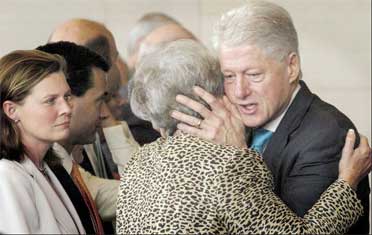 |
|
Arkansas Democrat-Gazette/STEVE KEESEE The area between the Interstate 30 bridge and the Clinton Presidential Center will become a wetlands project. |
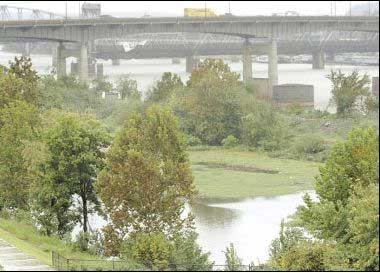 |
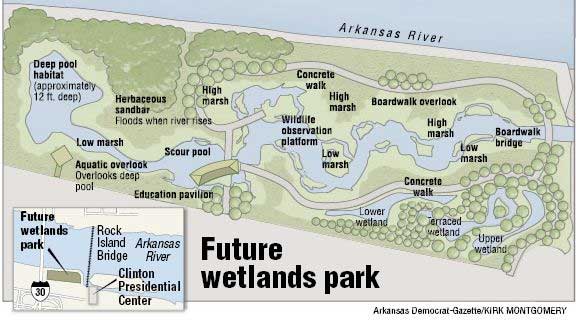 |
| Publication:Arkansas Outdoors; | Date:Oct 24, 2007; |
Clinton, Kumpuris kick off wetlands project
by Keith Stephens, Arkansas Game and Fish Commission
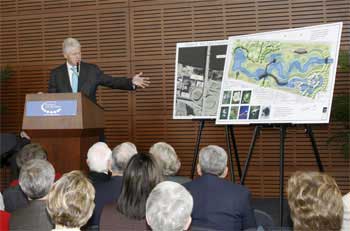 LITTLE
ROCK – As wetlands shrink across the country, former President Bill
Clinton and Little Rock City Director Dean Kumpuris announced plans to
create 13 acres along the Arkansas River.
LITTLE
ROCK – As wetlands shrink across the country, former President Bill
Clinton and Little Rock City Director Dean Kumpuris announced plans to
create 13 acres along the Arkansas River.
The pair, speaking Tuesday at the Clinton Presidential Center, unveiled the William E. Clark Presidential Park Wetlands Project, named for the man charged with building the Clinton Presidential Library. The area is adjacent to Clinton Presidential Park and Riverfront Park in downtown Little Rock. Kumpuris explained that the project will allow visitors to get a first-hand view of wetlands.
“Besides being scenic, important for animals and birds, it also is a source of cleansing of groundwater and all the pollutants that we put in wetlands,” Kumpuris said. “It is the filter system of free water in the United States and the world. We’re ruining habitat at a remarkable rate and taking away that.”
Trails and an elevated walkway will lead people into the project. Two bridges will afford views of the Arkansas River and the stream that will run through the wetlands. Displays will explain how wetlands works and help visitors identify plants and animals.
Clinton said a growing number of people have lost touch with nature and the project may help them reconnect.
“It’s very important that people who live in cities be able to enjoy nature and understand it. By and large, we don’t teach our children how the world around them works. If they live in cities, they have no idea how they get clean water or what happens when they turn on the sink or flush the toilet. They don’t understand what happens when the rainwater they see on the street runs into a drain.
“They don’t understand what a precious and increasingly scarce product clean water is and how it contributes to wildlife and vegetation that sustain life.”
The $2 million project, set to begin construction this winter, is a collaboration of The Conservation Fund, the Arkansas Game and Fish Commission and the William J. Clinton Foundation. Audubon Arkansas, the Arkansas Natural Heritage Commission , The Nature Conservancy, the Army Corps of Engineers, the University of Arkansas Clinton School of Public Service, the City Parks Conservancy and the City of Little Rock.
“The Game and Fish Commission had four (committee) members – Neil Curry, Jane Anderson, Steve Filipek and Elizabeth Murray – who brought great expertise at all levels, whether you’re talking about fish or habitat,” Kumpuris said. “We have an amazing group of people.”
Clinton said the project is much larger than a spit of land along the Arkansas River.
“This may seem like 13 acres to people who’ll just look at it and they’ll say, ‘Isn’t this beautiful and wasn’t it nice that that nice man’s friends gathered up money and set aside this land and they did this.’ This is way bigger than this. Bill Clark knew how things were built and he knew how nature worked. We have to teach the world how things are built and how nature works.”
Clark, who died of cancer at 63 last May 15, was chairman and chief executive officer of CDI Contractors LLC. He served many civic rolls, including stints on the University of Arkansas, Arkansas Arts Center and St. Vincent Infirmary Medical Center boards of trustees. He also was an outdoorsman who loved to duck hunt and – as Clinton pointed out – enjoyed a good game of golf.
“He loved building things and loved leaving Mother Nature alone. Last year I saw a fox on our wetlands site. Goodness knows how many foxes we’re going to get out there once we build them a bridge and make it easy for them,” Clinton said with a laugh. “We couldn’t have done anything that would have made Bill Clark happier.
“I see this wetlands project as just as important as the library. (The library) shows you how to build something and do it in an environmentally responsible, energy-efficient way. (Th| Publication:Arkansas Times; | Date:Oct 23, 2007; | City News Release; |
President Clinton Joins Friends &
Family Of Late Bill Clark To Unveil Plans For Wetlands Restoration
Project Will Be Lasting Memorial to Little Rock Civic Leader
LITTLE ROCK – Surrounded by family and friends of the late civic leader William E. “Bill” Clark, President Bill Clinton and Little Rock City Director Dean Kumpuris today unveiled the plans for the thirteen (13) acre William E. Clark Presidential Park Wetlands Project, which will be a lasting memorial to the Little Rock businessman, philanthropist, and outdoorsman who died earlier this year.
The Clark Wetlands Project involves the restoration of riverfront wetlands adjacent to the Clinton Presidential Park and Riverfront Park in downtown Little Rock. It is designed to showcase wildlife and river life in a restored wetlands habitat for the education and enjoyment of the hundreds of thousands of visitors each year to the Clinton Presidential Park and Library and Little Rock’s River Market District.
The William E. Clark Presidential Park Wetlands Project is the result of a national collaboration between The Conservation Fund, the Arkansas Game and Fish Commission, and the William J. Clinton Foundation. Also participating in the Clark Wetlands Project are Audubon Arkansas, the Arkansas Natural Heritage Commission, The Nature Conservancy, the U.S. Army Corps of Engineers, the University of Arkansas Clinton School of Public Service, the City Parks Conservancy, and the City of Little Rock.
The Wetlands is named for William E. “Bill” Clark, an avid outdoorsman and strong business, civic, charitable, and political leader in Arkansas for over three decades. The Clark and Dillard families created one of the South’s largest construction firms, CDI, of which Bill served as Chairman and Chief Executive Officer. Bill built his personal and professional reputation nationally as CDI successfully completed award-winning projects from coast to coast.
As the builder of the Clinton Presidential Library, Bill Clark and CDI turned the attention of the world to Little Rock for innovation, craftsmanship, skill, and quality in completing perhaps the most intriguing, efficient, environmentally-sensitive Presidential Library in our nation’s history.
In remembering his friend, President Clinton noted, “Bill Clark was respected and beloved throughout Arkansas for his leadership, generosity, candor, humor, and ability to make things happen. Throughout his career, he transformed many landscapes, and the transformation of the Wetlands is a tribute to him personally. It is also a major, environmentally-sensitive addition to the riverfront of Little Rock and to the area which is now the home of my Presidential Library and Heifer International world headquarters.”
Clark’s friend and fellow outdoorsman Dr. Kumpuris remarked, “Bill always loved the outdoors and devoted much of his time to preserving and enjoying it. An avid hunter and fisherman, he spent many sunrises and sunsets overlooking the Arkansas River and wetlands, enjoying nature. With this project, millions more will get to share that same experience and do so in the City that Bill loved next to two parks that he loved.”
The Clark Wetlands will provide unprecedented public access to conservation, tourism, educational, environmental, and wildlife opportunities. The project will feature pedestrian trails and an elevated walkway to provide access to the entire site. The Clark Wetlands will also include two bridges that offer spectacular views of the Arkansas River, the channel stream, and wetland and aquatic habitats. It will feature interpretive displays and observation pavilions for visitors, students, and patrons to both enjoy and learn from the Clark Wetlands.
Design for the William E. Clark Presidential Park Wetlands has been contributed in-kind by Larson Burns Smith, Inc. working with Landscape Architecture, Inc. The $2 million project is scheduled to being construction this winter.|
Arkansas Times Check the jump for the details on the 13-acre wetlands park to be build along the Arkansas River next to the Clinton Library. It will be named in honor of the late William Clark. |
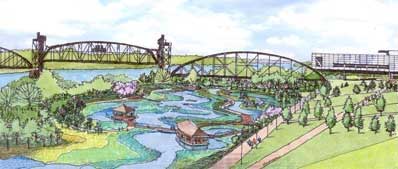 |
WILLIAM E. CLARK PRESIDENTIAL PARK WETLANDS
Facts
PROJECT AND DESIGN FEATURES:
· Arkansas Backwater Sandbar Habitat Restoration and Demonstration Area
-
Total Ecological Restoration ±5 Acres
-
Sandbar Habitat
Low Marsh
High Marsh
Herbaceous Sandbar
Shrub/Tree Sandbar
Native Grass, Forbs, Wildflower Seeded High Banks
Invasive Species Control
Management Plan
· Aquatic Habitat
-
Main Backwater Channel – 8’ deep/5’wide (1000 linear feet)
Side Backwater Channel - 3-5’ deep/5’ wide (150 linear feet)
Scour Pool – Storm water Outfall – Dissipate Energy
Deep Pool – 12’ deep – ¼ acre – Refuge of Cool Water during Summer
Channels constructed out of 12” diameter pine logs placed vertical – local renewable resource
Total Open Water Channel Width – 25’
10:1 Slope from Channel to Low Marsh
· Terrestrial Habitat
-
Bat Boxes
· Wildlife Viewing
-
Birds
Mammals
Amphibians
Reptiles
· Pedestrian Interaction/Education
-
Concrete Walks with Railing – 1750 linear feet (barrier free)
Boardwalks with Rail– 7500 square feet (barrier free)
Overlooks with Shade Structures
Constructed Wetlands Terraced with Clay Seal
Re-Circulate Water – Low flow solar pump
Solar Air Diffusers – Dissolved Oxygen Supporting Aquatic life
Native Trees
Native Ornamental Aquatics
· Storm water Filter and Trash Collection/Disposal Demonstration
-
Trash Boom vs. Oil Grease Separator
Maintenance Access to Main Storm water Drain line
Stormwater Watershed Area
Educational Opportunities
Contaminant Filter through Plant Material
· Arkansas River Hydrology
-
Controls every aspect of the project from design through construction
Normal Water Level 230
Level 233.00 for 50 days of the year
High water mark 243.00
BUDGET:
· Project Budget and Funding
-
Approximately $2 Million; combination of Federal grant money and private donations.
Private funds raised through contributions to the City Parks Conservancy in memory of William E. “Bill” Clark.
SCHEDULE:
· Construction will commence this winter
· Length of construction will be dictated by the Arkansas River
![]()
Announcements |
AWAP in the News |
Executive Summary |
Wildlife Action Plan
Database |
Ecoregions |
Grants
|
Legislative History
|
Resources |
Partners |
Home
© 2005 Designing A Future For Arkansas Wildlife All Rights Reserved
